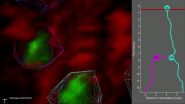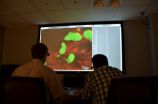(Press-News.org) VIDEO:
A software program developed by engineers at Drexel University, called Lineage Editing and Validation (LEVER), allows biologists to tag and track cell proliferation to validate lineage trees.
Click here for more information.
For hundreds of years biologists have studied cells through the lens of a microscope. With a little help from a team of engineers at Drexel University, these scientists could soon be donning 3-D glasses in a home-theater-like lab to take their own fantastic voyage into the petri dish.
Dr. Andrew Cohen, an associate professor of electrical and computer engineering in the College of Engineering, is leading a group of researchers who are developing software and hardware that will enable biologists to better track and study the movement and multiplication of cells. Their goal is to enhance the current visual data that these scientists are working with so that it's easier to identify changes in cells over time –information that is key to studying the abnormal cell proliferation that causes cancer and also to using stem cells in regenerative medicine.
"This type of imaging is so important because it allows us to see and measure relationships between cells and their environment," Cohen said.
Cohen, whose background includes developing operating systems support for computer games, has developed a program called LEVER –short for Lineage Editing and Validation program- that can identify, tag and track live cells, capturing patterns of motion and cell division, using sequences of microscopic time-lapse images. His work was recently published in the journal BMC Bioinformatics.
Typically the process of tracking cell lineage over time requires biologists to watch the time-lapse images and note by hand when the cells multiply –creating a graphic representation of cell division over time called a "lineage tree." It can take a researcher several tedious hours to create a tree. The LEVER software lets the researcher work with the computer to delineate cells, color code them and denote the exact moment of their division. LEVER is easier and more accurate than processing the data manually and also provides more data than what can be obtained by hand.
"It's like Photoshop for cell biologists," Cohen said. "The software outlines cells and blood vessels, keeping track of them as they're dividing and moving around one another. This provides a wealth of information on the patterns of cell shape, motion and division. Visualization of the 3-D microscopy data together with the analysis results is a key step to measure and ultimately understand what drives these cells."
With an enhanced version of the program called LEVER 3-D, which compiles data from multi-layered microscopic images, Cohen's team can produce a three-dimensional rendering of the cells and animate it through time to show their multiplication and movement. The enhanced imaging gives researchers a unique view of the interaction of stem cells with their surroundings.
By running the software on a computer with a graphics card optimized for gaming and donning a set of 3-D gaming glasses, the program can take scientists inside the microscopic cross section. In a portion of Cohen's lab modified to be a viewing theater, a special stereo-vision projector brings the three-dimensional image data to life. Users can rotate and zoom in and out of the projected image in true 3-D, giving scientists vantage points that are not possible when looking through a microscope.
"LEVER 3-D is amazing, it opens new vistas for understanding the stem cell niche," said Dr. Sally Temple, a cell biologist at the Neural Stem Cell Institute in Rensselaer, N.Y. who has been using Cohen's software, through the course of its development, as part of her stem cell research since 2005. Cohen's goal is to make the software open-source and readily available to any scientists who can use it for their research.
The project, which is funded by the National Institute on Aging, was recently presented by Eric Wait, a doctoral researcher in Cohen's lab, at the Symposium on Biological Data Visualization in Boston. The team will continue to add interactive capabilities to their system as it becomes more widely used as a research tool.
INFORMATION:
FALLS CHURCH, Va. (October 3, 2014) — A new National Institute for Occupational Safety and Health (NIOSH) study, published online in the Journal of Occupational and Environmental Hygiene, found that recommended safe handling practices for workers who administer antineoplastic drugs in healthcare settings are not always followed.
Results are derived from the 2011 Health and Safety Practices Survey of Healthcare Workers, the largest federally-sponsored survey of healthcare workers in the U.S., which addresses safety and health practices relative to use of hazardous chemicals. ...
Washington, DC—The Endocrine Society today issued a Clinical Practice Guideline (CPG) advising against the use of testosterone therapy in healthy women.
The CPG, entitled "Androgen Therapy in Women: A Reappraisal: An Endocrine Society Clinical Practice Guideline," was published online in the Journal of Clinical Endocrinology and Metabolism (JCEM), a publication of the Endocrine Society. The Society updated its 2006 recommendations to address new research concerning testosterone and dehydroepiandrosterone (DHEA) therapy in women as well as advances in testosterone testing ...
Luis Fernando Velásquez-García's group at MIT's Microsystems Technology Laboratories (MTL) develops dense arrays of microscopic cones that harness electrostatic forces to eject streams of ions.
The technology has a range of promising applications: depositing or etching features onto nanoscale mechanical devices; spinning out nanofibers for use in water filters, body armor, and "smart" textiles; or propulsion systems for fist-sized "nanosatellites."
In the latest issue of the IEEE Journal of Microelectromechanical Systems, Velásquez-García, his graduate students Eric ...
Cincinnati, OH, October 3, 2014 -- Increasing rates of adolescent obesity and the likelihood that obesity will carry forward into adulthood, have led to various preventive initiatives. It has been suggested that family meals, which tend to include fruits, vegetables, calcium, and whole grains, could be protective against obesity. In a new study scheduled for publication in the Journal of Pediatrics, researchers studied whether frequent family meals during adolescence were protective for overweight and obesity in adulthood.
Jerica M. Berge, PhD, MPH, LMFT, CFLE, and ...
In the field of medicine there has often been a divide between those who focus on modern medicine and those who prefer alternative practices. But pediatrician Sunita Vohra is a firm believer there should be room for both.
A new study from Vohra, a professor in the Faculty of Medicine & Dentistry's Department of Pediatrics at the University of Alberta, and a pediatric physician for Clinical Pharmacology with Alberta Health Services, is giving insight into the use of alternative medicines by pediatric cardiac patients and how effective they are seen to be. "We wanted to ...
Tel Aviv — The incidence of type 1 childhood diabetes has been increasing rapidly worldwide. If blood sugar levels aren't well-controlled, juvenile diabetes can affect nearly every organ of a child's body. And while long-term complications of the disease develop gradually, they may become disabling and even life-threatening. The exact cause of juvenile diabetes has eluded scientists, but a new study from Tel Aviv University suggests a likely trigger before birth.
In a recent paper published in Diabetic Medicine, Prof. Zvi Laron, Professor Emeritus of Pediatric Endocrinology ...
A team of researchers, led by the Optoelectronics Research Centre (ORC) at the University of Southampton, has demonstrated a breakthrough technique that offers the first possibility of silicon detectors for telecommunications.
For decades, silicon has been the foundation of the microelectronics revolution and, owing to its excellent optical properties in the near- and mid-infrared range, is now promising to have a similar impact on photonics.
The team's research, reported in the journal Nature Materials, describes engineering the electronic band structure of laser-crystallised ...
A study conducted in more than 100 Mongolian schoolchildren found that daily treatment with a vitamin D supplement significantly reduced the symptoms of winter-related atopic dermatitis, a type of eczema. Led by a Massachusetts General Hospital (MGH) physician, the report in the October issue of the Journal of Allergy and Clinical Immunology supports the results of a preliminary study that showed similar results in a small group of children in Boston.
"While we don't know the exact proportion of patients with atopic dermatitis whose symptoms worsen in the winter, the ...
As global life expectancy increases, adults want to maintain healthy and active lifestyles well into retirement. In fact, research shows that adults think, feel and behave five to ten years younger than their actual age.1-2 But new findings from a review paper published in Age and Ageing show that approximately one out of three adults age 50 and older suffer from sarcopenia, a condition that could interfere with aging adults' ability to live a full and active life.3
Sarcopenia, as it is known in the medical field, is a condition when a person has progressive loss of ...
CAMBRIDGE, Mass--When someone crumples a sheet of paper, that usually means it's about to be thrown away. But researchers have now found that crumpling a piece of graphene "paper" — a material formed by bonding together layers of the two-dimensional form of carbon — can actually yield new properties that could be useful for creating extremely stretchable supercapacitors to store energy for flexible electronic devices.
The finding is reported in the journal Scientific Reports by MIT's Xuanhe Zhao, an assistant professor of mechanical engineering and civil and environmental ...



